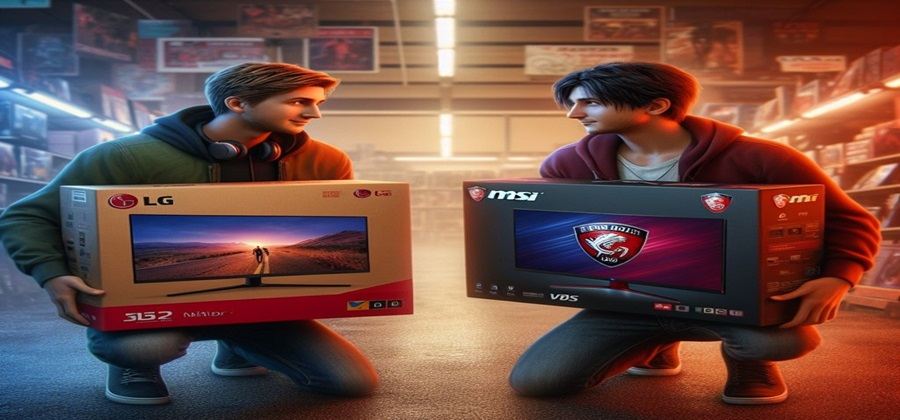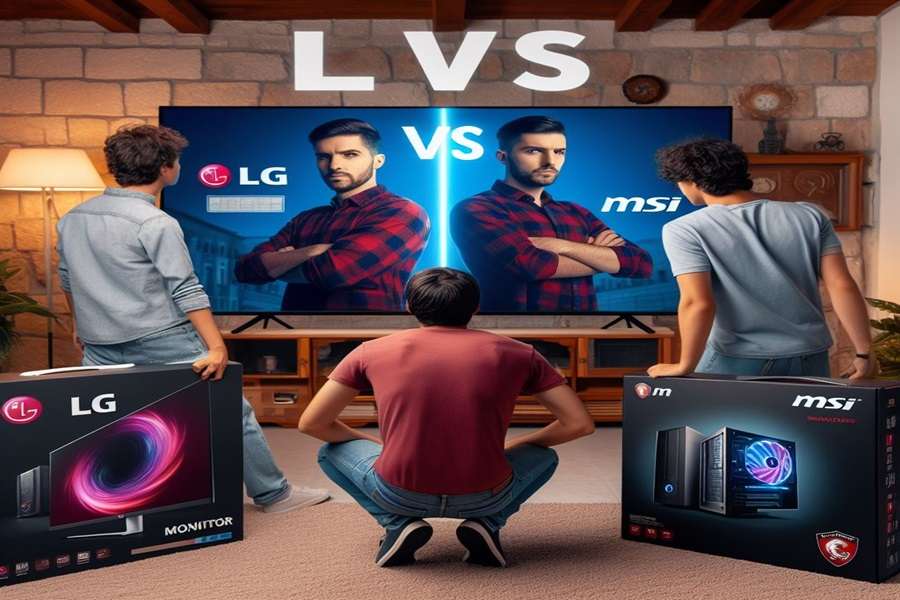
LG gaming monitors are the best overall choice for most gamers seeking excellent all-around picture quality and performance. MSI specializes more in affordable esports-focused displays optimizing speed for competitive titles. Ultimately LG wins through unrivaled color accuracy and versatile features benefitting casual and hardcore gamers alike.
Gaming monitors have come a long way in recent years. With ultra-fast refresh rates, adaptive sync technologies, and curved screen designs now commonplace, picking the right gaming display for your needs is more important than ever.
Two of the biggest brands in gaming monitors are LG and MSI—but which one reigns supreme in 2024? By the end, you’ll know which brand best fits your gaming rig through a detailed feature-by-feature LG vs MSI monitor comparison.
LG vs MSI Brand Overview
LG has established itself as an elite display brand in recent years through industry-leading picture quality in its TV and high-end monitors. The company’s expertise with panel technologies gives LG gaming monitors superb color accuracy and versatile feature sets.
MSI meanwhile rose to prominence by equipping some of esports’ top professional gamers through its partnerships. The company’s gaming monitors prioritize blisteringly quick response times and tear-free visuals.
By evaluating LG and MSI’s gaming monitors side-by-side on important criteria like price, performance, and overall value, we’ll determine which monitor brand delivers the absolute best bang for your buck in 2024.

Compare Picture Quality
When it comes to visuals, LG gaming monitors leverage the company’s expertise in display technologies like IPS panels. These IPS panels offer wide 178°/178° viewing angles along with vibrant, accurate color.
LG’s current lineup of gaming monitors feature nano IPS display technology. Nano IPS introduces nanoparticles into the panel’s liquid crystal layer for improved brightness and color volume. LG also factors in wide color gamut support and factory calibration for additional color accuracy out of the box.
In contrast, MSI’s gaming monitors primarily utilize curved VA panel technology instead for the enhanced contrast and black levels—an advantage for dark horror and sci-fi games. However, the color reproduction and viewing angles on IPS panels still give LG the edge overall for color performance.
Specifically, LG’s nano IPS gaming monitors cover over 95% of the DCI-P3 color gamut. That results in richer reds and greens that “pop” more compared to the average VA panel from MSI. Plus, IPS monitors do not exhibit color shifting when viewed from off-angles either.
Response Times Comparison
Quick pixel response times eliminate distracting motion blur and ghosting effects during fast-paced gaming. Here, MSI’s VA panel monitors hold a slight edge over IPS technology when it comes to rapid gray-to-gray (GtG) response times.
For example, MSI’s MAG251RX model delivers a blistering 0.5ms GtG response time along with MSI’s Motion Picture Response Time (MPRT) technology. Combined, this reduces motion blur substantially for highly competitive esports gaming in titles like CS:GO or Valorant.
Comparatively, even LG’s quickest 1ms IPS gaming monitors average a 4ms GtG response time typically. However, LG’s current UltraGear models do include features like NVIDIA G-Sync compatibility and black frame insertion (BFI). These help compensate for the higher response time of IPS panel displays.
Importantly though, many manufacturers exaggerate “1ms” response time claims through misleading settings, so buyers must read the fine print. LG’s “1ms” velocity specification factors in overdrive compared to MSI’s raw 0.5ms GtG claim for example. We recommend researching reviews on a model’s real-world performance rather than solely relying on listed numbers.
Table Comparing Refresh Rates
| Refresh Rate | LG Models | MSI Models |
|---|---|---|
| 60Hz | LG UltraGear, LG UltraWide | MSI Optix G241, MSI Optix G271 |
| 144Hz | LG 27GL850, LG32GN50T | MSI Optix MAG274R |
| 240Hz | LG UltraGear 27GP950 | MSI Oculux NXG253R |
| 360Hz | None Currently | MSI MEG381CQR Plus |
Compare Adaptive Sync Support
Adaptive sync technologies like NVIDIA G-Sync and AMD FreeSync dynamically match your monitor’s refresh rate with your graphics card’s frame rate. This prevents screen tearing (horizontal lines) and stuttering for extremely smooth gameplay.
Both LG and MSI offer gaming monitors compatible with the two technologies across varied budgets and specs. For example, LG lists both G-Sync Compatible and FreeSync Premium support on popular models like the 27-inch UltraGear 27GP850.
MSI also incorporates adaptive sync in most of its curved Optix gaming monitors using VA panels plus additional Motion Picture Response Time (MPRT) tech. This includes widely-praised options like the MSI Optix MAG274QRF-QD 1440p model.
Generally, LG offers G-Sync/FreeSync capabilities slightly more consistently across its gaming monitor product stack though. From affordable 1080p UltraGears to premium 4K models to extra-large UltraWide displays, LG enables tear-free variable refresh rates almost universally.
Connectivity Differences
The connectivity ports available on a gaming monitor determine what devices you can connect to the display. Both LG and MSI incorporate modern inputs like HDMI 2.1 and DisplayPort 1.4 to support features equivalent to the latest consoles and GPUs.
Specifically, LG UltraGear models include:
- HDMI x2 (majority version 2.1)
- DisplayPort 1.4
- Headphone jack
Plus some UltraGears add USB 3.0 ports for convenient charging of accessories and peripherals right from your monitor.
MSI’s curved Optix gaming monitors typically offer:
- HDMI x2 (majority HDMI 2.0b)
- DisplayPort 1.2a
- Headphone jack
- USB ports
So LG reserves HDMI 2.1 and DisplayPort 1.4 for current-generation models exclusively. Comparatively, lower-cost MSI Optix displays settle for HDMI 2.0 and DP 1.2 connectivity in some cases. Yet real-world performance differences between those standards and new HDMI 2.1/DP 1.4 generally prove minimal.
Where LG gaming monitors excel most is through the incorporation of a built-in USB hub with fast charging capabilities. Select UltraGear models feature rapid charging rates up to 94 watts over their USB ports. This benefits power-hungry peripherals like gaming headsets and keyboards. MSI strangely omits USB hubs entirely on many Optix series monitors however.
Design and Aesthetics
Gaming monitors aim to catch your eye through aggressive, non-traditional styling full of angles and LED lighting flair. Here both LG and MSI brands oblige with striking looks catering to gamers.
For example, LG’s UltraGear line features metallic gray finishes with glowing red accents and narrow bezels. Plus a sphere light on certain models creates unique ambiance projection effects behind the display.
MSI’s Optix monitors take an equally bold direction through combinations of black finishes mixed with LED strips configurable to multiple colors. Plus signatures like MSI’s winged dragon logo etched into monitor feet grab attention.
In terms of ergonomic flexibility, LG UltraGears typically offer tilt, pivot, height, and swivel adjustments. This allows moving the panel left/right along with changing height and angle as needed.
By comparison, MSI equips some Optix models like the MAG274QRF with tilt, swivel, and height alterations while cheaper options lack pivot capabilities. So ergonomics skew a bit more versatile on LG’s gaming monitor lineup overall.

Pricing and Warranties
Gaming monitors can range from affordable 1080p displays under $300 up through 4K HDR models over $1,000. Across varied budgets, LG and MSI position their gaming monitors competitively on pricing.
As a general rule, equivalent LG UltraGear and MSI Optix models sell within $50 or less of each other typically. For example, popular 1440p, 144Hz gaming monitors from both brands land around $350. So no substantial pricing advantage exists choosing LG vs MSI.
For warranties though, LG includes exceptionally strong 3 year coverage compared to just 1 year from MSI. Having 2 extra years of manufacturer protection provides fantastic extra peace of mind buying an LG UltraGear monitor. Defective panel policies also favor LG should anything go amiss down the road.
Frequently Asked Questions
Which is better for competitive gaming?
MSI’s gaming monitors edge out LG overall if you play fast-paced competitive esports titles. The ultra-quick response times of MSI’s VA panel Optix monitors combined with up to 360Hz refresh rates gives them an advantage for games like CS:GO, Valorant, and more demanding shooters.
Which brand has better HDR performance?
LG’s latest displays leverage mini LED backlighting for elite HDR support surpassing any MSI gaming monitor currently. Models like the LG UltraGear 48GQ900-B can sustain up to 1,500 nits brightness withrich, precise dimming control from mini LED backlights with nearly 2,500 zones. This beats VA rivals.
Are LG or MSI monitors better for console gaming?
LG and MSI both enable next-gen HDMI 2.1 inputs for 4K 120Hz gaming support matching PlayStation 5 and Xbox Series X capabilities. So either brand works extremely well. LG adds the bonus of built-in USB ports on most models too for charging controllers via your display.
Which is the more budget-friendly brand?
When it comes to cheaper 1080p gaming monitors, MSI and LG compete closely on pricing. Yet the lower-end MSI Optix G241 and G271 retail around $50-75 less normally for equivalent refresh rates and features. So if seeking a tighter budget gaming monitor, MSI gives shoppers a small value advantage.
Final Thoughts
So which brand of gaming monitors reigns supreme in 2023? After comparing LG and MSI models directly on picture quality, performance, features, design, price, and warranty coverage, LG gaming monitors earn the slight overall edge.
While MSI impresses with their curved VA panels prioritizing speed for esports gaming, LG simply offers more versatile, well-rounded gaming monitors benefitting casual and competitive gamers alike.
Nano IPS panels backed by LG’s display prowess enable unrivaled color accuracy, viewing angles, and brightness. Plus you gain adaptive sync, ample connectivity, and striking yet flexible aesthetic designs with UltraGear too. All wrapped up with long 3 year warranties seldom matched in the gaming monitor space.
Consider MSI to maximize competitive esports gaming specifically on a budget. Yet most gamers appreciate LG’s industry-leading monitors marrying performance with elite, consistent image quality across the board.

A former esports professional turned tech journalist, Aiden Johnson is on a mission to help gamers optimize their setups. His expertise extends beyond gaming monitors, encompassing the broader tech ecosystem. Known for breaking down complex topics into digestible pieces, Aiden provides a holistic view of how monitors fit into the larger gaming and tech landscape.